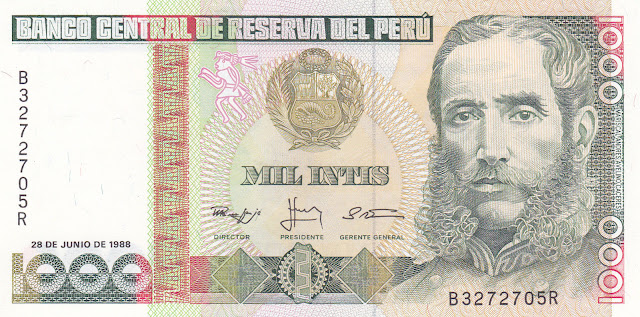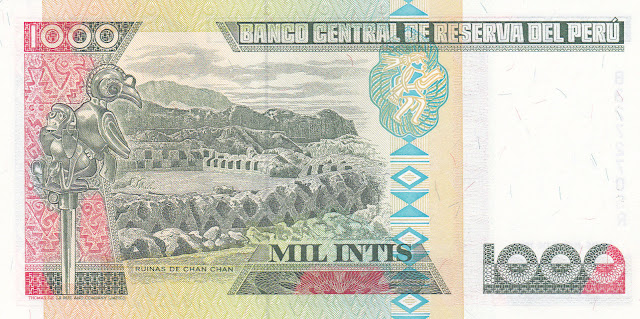Peru Banknotes 1000 Intis banknote 1988 Marshal Andres Avelino Caceres
Central Reserve Bank of Peru - Banco Central de Reserva del Perú
Obverse: Portrait of Marshal Andrés Avelino Cáceres Dorregaray (1836 – 1923); Peruvian art; Coat of arms of Peru at upper center.
Reverse: Ruins of Chan Chan, located near Trujillo - the largest Pre-Columbian city in South America; Treasure of the Inca at left.
Watermark: Andrés Avelino Cáceres.
Printer: Thomas De La Rue and Company, Limited.
Date of Issue: 28 June 1988.
Peru Banknotes - Peruvian Paper Money
1985-1991 "Inti" Issue
The inti was introduced on 1 February 1985, replacing the sol which had suffered from high inflation. One inti was equivalent to 1,000 soles. Coins denominated in the new unit were put into circulation from May 1985 and banknotes followed in June of that year.Andrés Avelino Cáceres
Andrés Avelino Cáceres Dorregaray (November 10, 1836 – October 10, 1923) was three times President of Peru during the 19th century, from 1884 to 1885, then from 1886 to 1890, and again from 1894 to 1895. In Peru, he is considered a national hero for leading the resistance to Chilean occupation during the War of the Pacific (1879–1883), where he fought as a General in the Peruvian Army. The government awarded him the rank of Marshal on November 10, 1919. Cáceres died on October 10, 1923 in the town of Ancón at the age of 90.
Chan Chan
Chan Chan, great ruined and abandoned city, the capital of the Chimú kingdom (c. ad 1100–1470) and the largest city in pre-Columbian America. It is situated on the northern coast of present-day Peru, about 300 miles (480 km) north of Lima in the Moche valley, between the Pacific Ocean and the city of Trujillo. Chan Chan was designated a UNESCO World Heritage Site in 1986.
The ruins of Chan Chan, which cover nearly 14 square miles (36 square km), are in fairly good condition because the area is usually rainless. The building material used was adobe brick, and the buildings were finished with mud frequently adorned with patterned relief arabesques. The centre of the city consists of several walled citadels, or quadrangles. Each of these contains pyramidal temples, cemeteries, gardens, reservoirs, and symmetrically arranged rooms. These quadrangles presumably were the living quarters, burial places, and storehouses of the aristocracy. Most of the city’s population — artisans and farmers — lived outside the quadrangles in modest quarters of less-durable construction.
Ruled from Chan Chan, the Chimú kingdom was for two centuries the chief state in Peru. It extended approximately from Piura in the north to Paramonga in the south. Its economy was based on agriculture, which in that dry region was supported by irrigation ditches. The Chimú seem to have elaborated a system of social-class stratification. Craftsmen produced fine textiles and gold, silver, and copper objects; a polished blade pottery was mold-made and produced according to standardized designs.
As successors to the Moche civilization, the Chimú spoke Yunca (Yunga, or Moche), a now-extinct language, but had no writing system. Between 1465 and 1470 they came under Inca rule, apparently persuaded that Inca arms were invincible. Chimú historical and mythological traditions were recorded by Spanish writers after the conquest (c. 1532).

